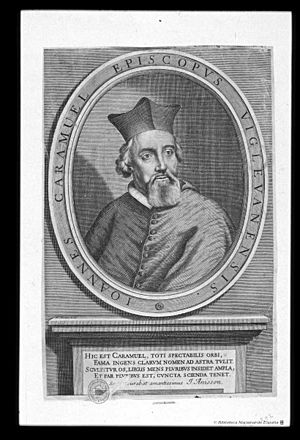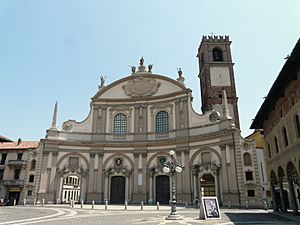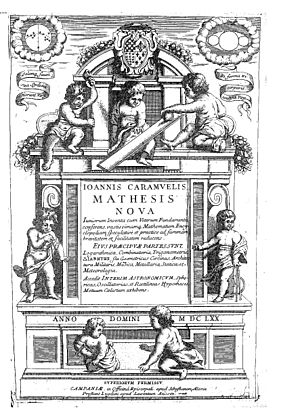Juan Caramuel y Lobkowitz facts for kids
Quick facts for kids Most Reverend Juan Caramuel y Lobkowitz |
|
|---|---|
| Bishop of Vigevano | |
 |
|
| Church | Catholic Church |
| Diocese | Vigevano (1673–1682) Campagna e Satrianum (1657–1673) |
| Successor | Ferdinando de Rojas |
| Orders | |
| Consecration | 29 July 1567 by Cardinal Francesco Brancaccio |
| Personal details | |
| Born | 23 May 1606 Madrid, Spain |
| Died | 8 September 1682 Vigevano, Italy |
| Nationality | Spanish
Philosophy career |
| Education | University of Alcalá University of Salamanca Old University of Leuven (Ph.D., 1629; Th.D., 1638) |
| Era | 17th-century philosophy |
| Region | Western philosophy |
| School | Aristotelianism Scholasticism Probabilism |
| Institutions | University of Salamanca Old University of Leuven |
|
Main interests
|
Metaphysics, moral philosophy, mathematics, astronomy |
|
Notable ideas
|
Binary mathematics |
|
Influences
|
|
| Occupation | mathematician and theologian |
| Previous post | Grand-Vicar to the Archbishop of Prague |
Juan Caramuel y Lobkowitz (born May 23, 1606, in Madrid, Spain – died September 8, 1682, in Vigevano, Italy) was a Spanish Catholic scholar. He was a very talented person who worked as a philosopher, church leader, mathematician, and writer. He is thought to be a great-grandson of a Czech noble family.
Contents
A Life of Learning and Adventure
Juan Caramuel was born in Madrid in 1606. His father was Count Lorenzo Caramuele, and his mother was Caterina Frissea von Lobkowitz. She came from a noble family in the Czech Republic.
He was a very smart child from a young age. He started studying difficult math problems early on. When he was only ten years old, he even published a book about astronomy called Camuelis primus calamus.
He studied many languages, including Chinese. At 17, he went to the University of Alcalá de Henares to study humanities and philosophy.
Becoming a Cistercian Monk
In 1625, Juan joined the Cistercian Order, a group of monks, at a monastery in Spain. After becoming a priest, he had a very busy and successful career. He taught in different monasteries and traveled to Portugal to study more languages.
From 1635 to 1644, he lived in the Low Countries (which are now Belgium and the Netherlands). His sermons, which are religious speeches, were very popular.
Helping Defend Louvain
While in Flanders, Juan helped defend the city of Louvain. He worked as an engineer and chief of works during attacks by the French and Dutch armies. Because of his bravery and skill, he was made a court preacher.
He also became friends with Marie de' Medici, the former queen-mother of France. Through her, he was given important church roles, like being the Abbot of Melrose in Scotland.
Doctor of Theology and Return to Catholicism
In 1638, Juan earned his Doctor of Theology degree from the University of Leuven. He then traveled through Belgium and Germany, preaching and encouraging people to return to the Catholic faith. It is said that he helped about 30,000 people do so.
Juan's patron, a supporter named Cardinal Infante Ferdinand, passed away in 1641. Juan then became an envoy, or representative, for the King of Spain to the court of Emperor Ferdinand III in Prague.
He held several important church positions, including Abbot of the Emmaus Monastery in Prague. He also served as the Grand-Vicar to the Archbishop of Prague.
Defending Prague
In 1648, when the Swedish army attacked Prague, Juan Caramuel showed great courage. He organized and led a group of church members to help defend the city. The emperor was so impressed by his bravery that he gave him a special gold collar.
Juan was very active in the political and religious events of his time. He worked hard to bring people back to the Catholic Church. This sometimes caused disagreements, even among other Catholics. Because of this, he eventually moved from Central Europe to Italy.
Becoming a Bishop
In 1656, Juan visited Rome. Pope Alexander VII, who greatly admired Juan's work, appointed him as a special advisor for important church matters. Soon after, in 1657, he became the Bishop of Campagna e Satrianum, a diocese in Italy.
In 1673, he was appointed Bishop of Vigevano, near Milan. He served in this role until he passed away on September 8, 1682.
Juan Caramuel was in touch with many famous scholars of his time. These included philosophers like René Descartes, scientists like Athanasius Kircher, and astronomers like Johannes Hevelius.
Juan Caramuel's Amazing Works
Juan Caramuel wrote an incredible number of books and papers. He published over 260 works on many different subjects! These included grammar, poetry, math, astronomy, architecture, physics, and theology.
He liked to explore new ideas and didn't always follow the popular ways of thinking of his time. In one of his books, Theologia moralis, he even tried to solve religious problems using mathematical rules.
Contributions to Mathematics
Juan Caramuel made important contributions to mathematics, especially in the areas of combinatorics (the study of counting and arranging things) and probability (the study of chance). He helped explain the work of other mathematicians on dice games.
He also came up with a new way to approximate trisecting an angle (dividing an angle into three equal parts). He was also the first mathematician to deeply study number systems that were not based on ten (like our usual decimal system). This was a big step in developing the binary numeral system, which uses only 0s and 1s, and is used in computers today!
Architectural Design
Juan Caramuel was also a talented architect. He designed the beautiful front of the Vigevano Cathedral in Italy. His design showed off his skill in using geometry in architecture.
Some of His Printed Works
- Philippus Prudens, Antwerp, 1639.
- Respuesta al Manifiesto del Reyno de Portugal, Antwerp, 1641.
- Rationalis et realis philosophia, Leuven, 1642.
- Theologia moralis fundamentalis, Frankfurt, 1652–1653.
- Theologia rationalis, Frankfurt, 1654–1655.
- Theologia moralis fundamentalis, second edition, Rome, 1656.
- Primus calamus, Rome, 1663.
- Arquitectura civil recta y oblicua..., Vigevano, 1678[-1679].
- Leptotatos, latine subtilissimus, Vigevano 1681 (in Latin).
Images for kids
See also
 In Spanish: Juan Caramuel para niños
In Spanish: Juan Caramuel para niños
- List of Roman Catholic scientist-clerics
- Lobkowicz




